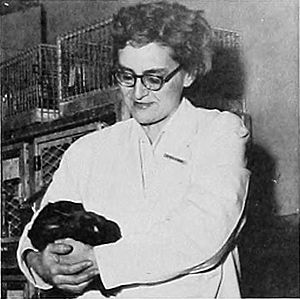Helen Ranney facts for kids
Helen Margaret Ranney (born April 12, 1920 – died April 5, 2010) was an amazing American doctor. She was also a hematologist, which means she was a special doctor who studied blood and blood diseases. Helen Ranney made very important discoveries about a blood condition called sickle-cell anemia.
Helen Ranney's Early Life
Helen Ranney grew up on a dairy farm in Summer Hill, New York. Her mom was a teacher, and both her parents really encouraged her to study hard. They wanted her to have a professional career.
She went to a small one-room school when she was little. Later, she attended Barnard College and graduated in 1941. At first, she thought about studying law. But while at college, she decided to become a doctor instead. She once said, "Medicine attempts to fix what it studies."
It was a bit tough for women to get into medical school back then. But during World War II, rules changed, and she was able to get into the College of Physicians and Surgeons at Columbia University.
Helen Ranney's Amazing Career
After becoming a doctor, Helen Ranney became a professor at Harvard Medical School. She also worked as a doctor at Brigham and Women's Hospital.
She achieved many "firsts" for women in medicine!
- She was the first woman to lead the Association of American Physicians.
- She was also the first woman to be president of the American Society of Hematology.
- She was one of the first women allowed into the American Society for Clinical Investigation.
- She was the first woman honored as a "Distinguished Physician" by the Veterans Administration.
Her important research on hemoglobin (a part of red blood cells) began in 1953. She was the first to use a special method called paper electrophoresis to separate human hemoglobin. This work helped doctors understand how sickle-cell disease is passed down in families. In 1960, she helped start a special clinic at the Albert Einstein College of Medicine to study inherited diseases.
Later, Dr. Ranney became a faculty member at the University of California, San Diego School of Medicine. She was the first woman to lead the department of medicine there. In 1973, she was chosen to be a member of the National Academy of Sciences and the Institute of Medicine. In 1975, she was also elected a Fellow of the American Academy of Arts and Sciences.
Awards and Special Recognitions
Dr. Helen Ranney received many honors for her groundbreaking work:
- In 1972, she received the Dr. Martin Luther King, Jr., Medical Achievement Award. This was for her work on blood disorders, especially her discoveries about the unusual blood cells and genes linked to sickle cell anemia.
- She was the first woman to be President of the Association of American Physicians.
- She was the first woman to be honored as a Distinguished Physician of the Veterans Administration.
- She served as President of the American Society of Hematology.
- She was named a Master of the American College of Physicians.
- In 1973, she was elected to the Institute of Medicine, which is now part of the National Academies of Sciences, Engineering, and Medicine.


